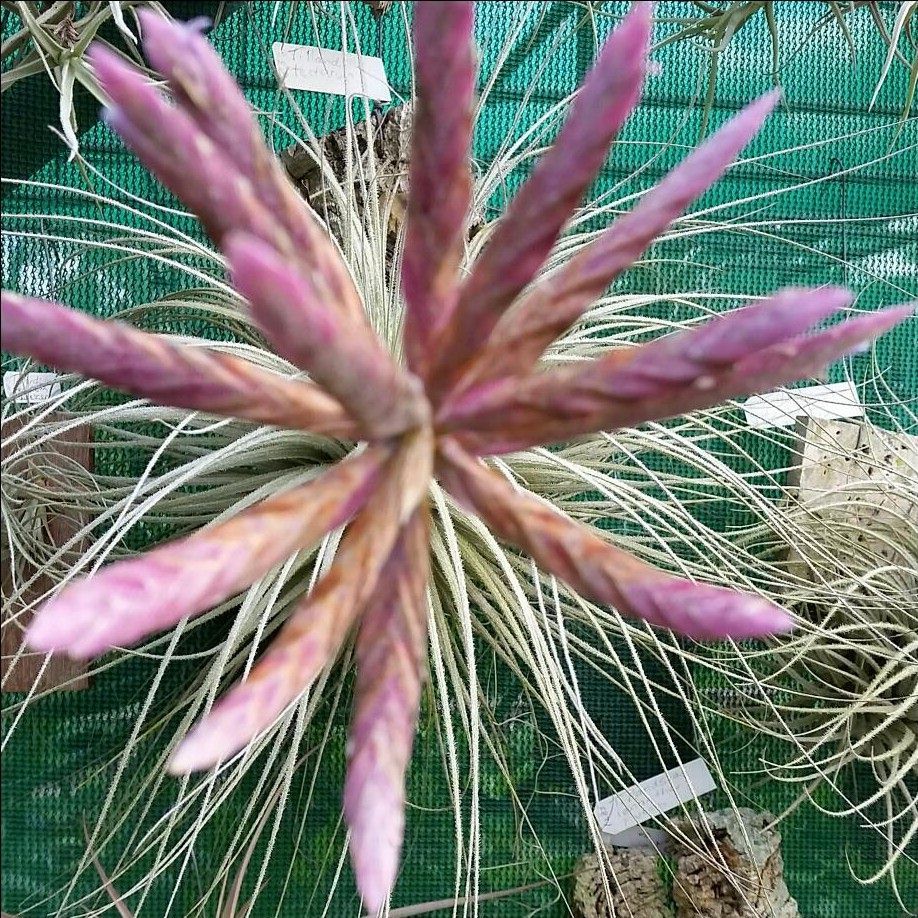
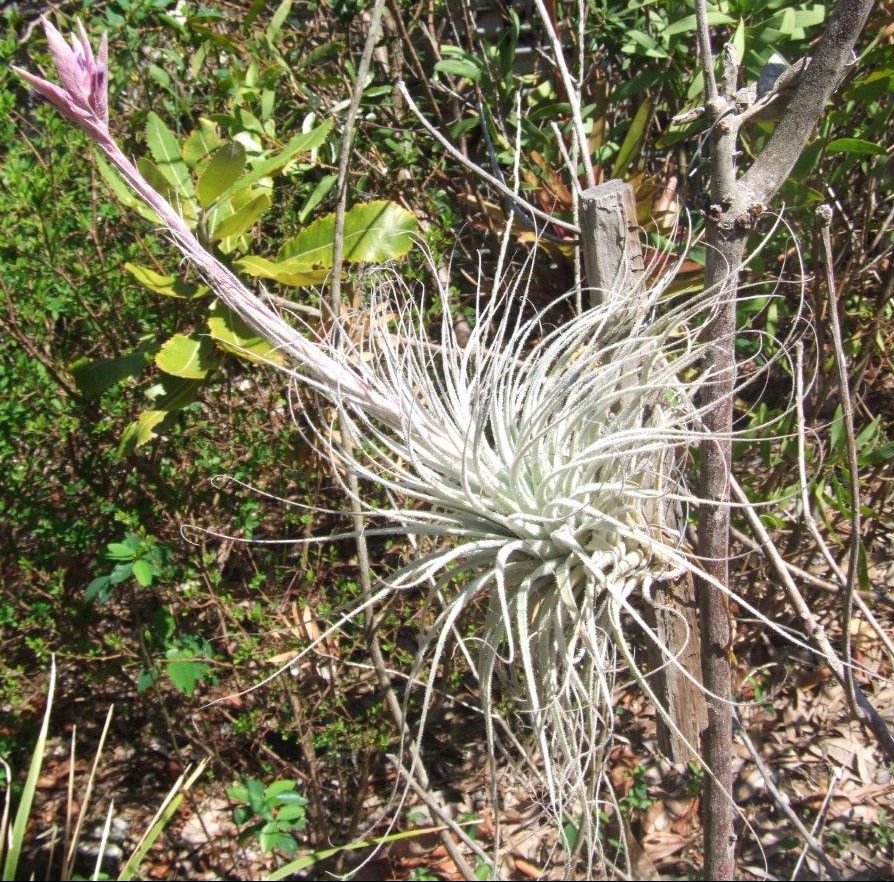
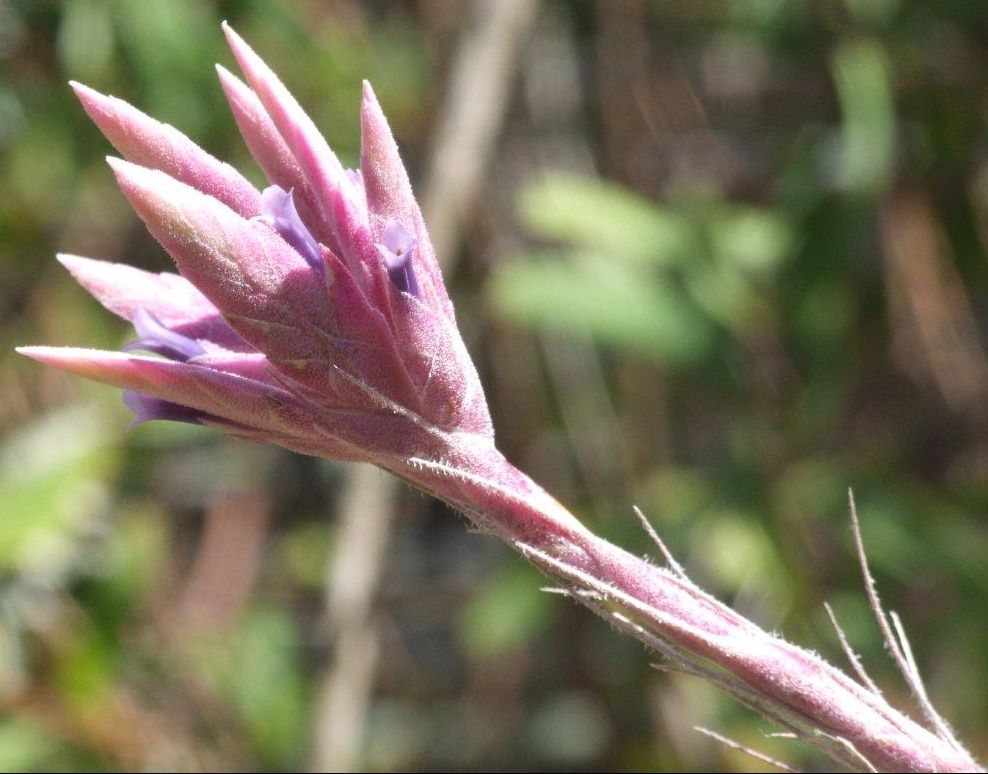
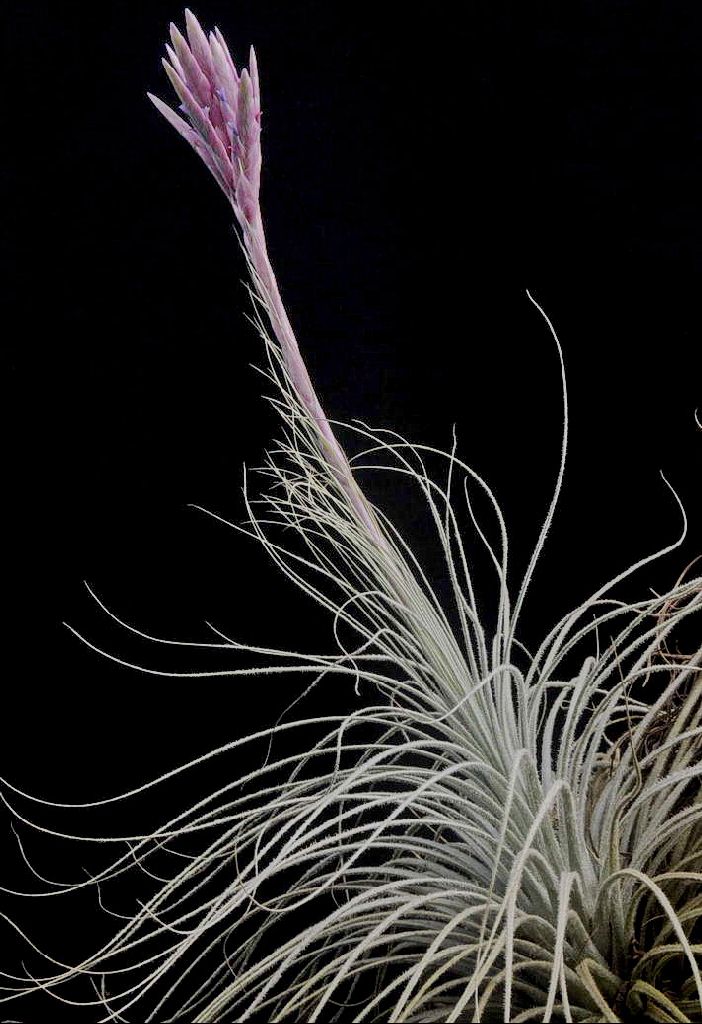
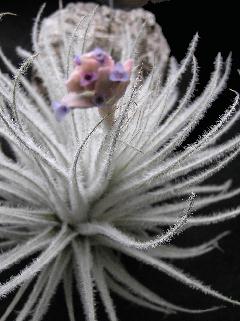
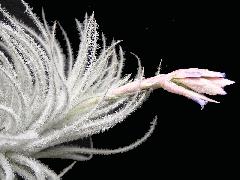
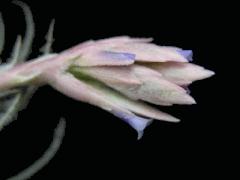
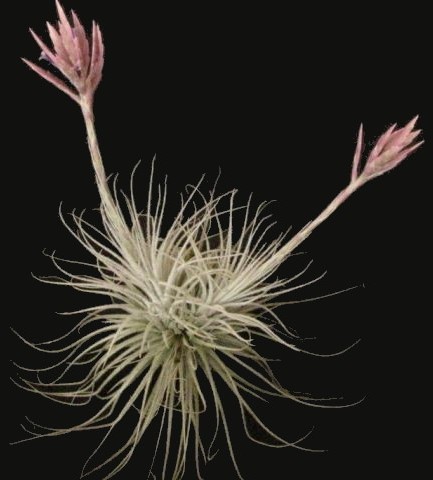
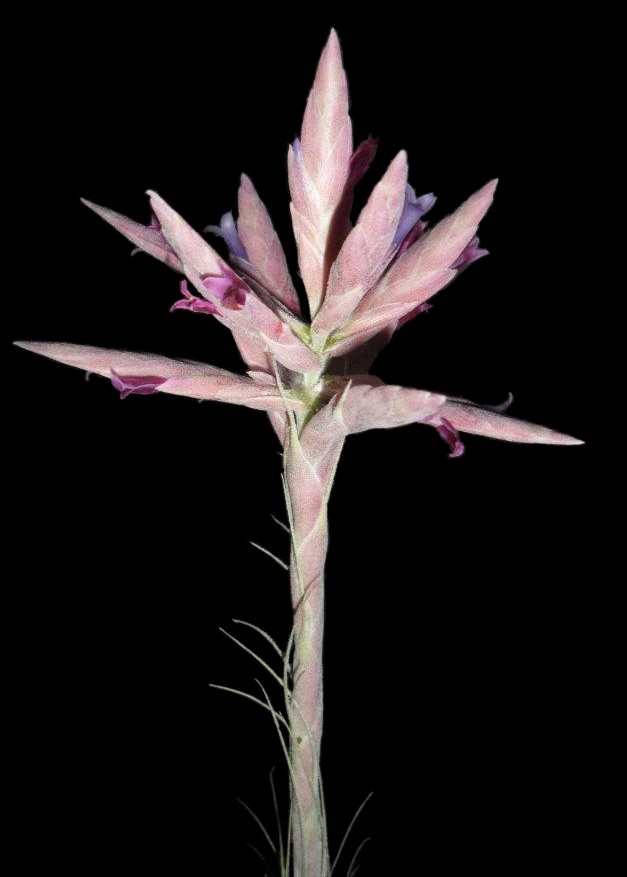
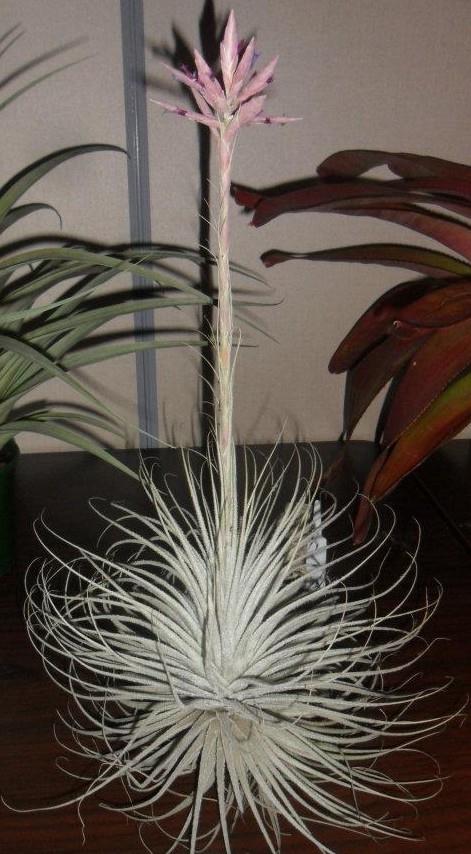
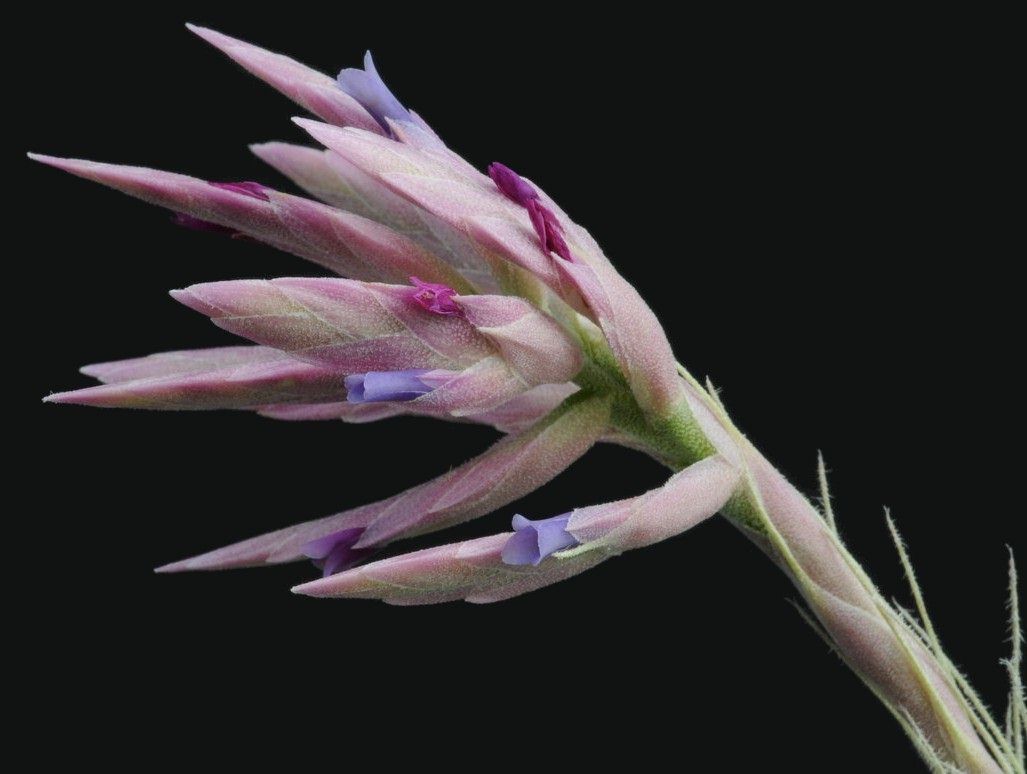
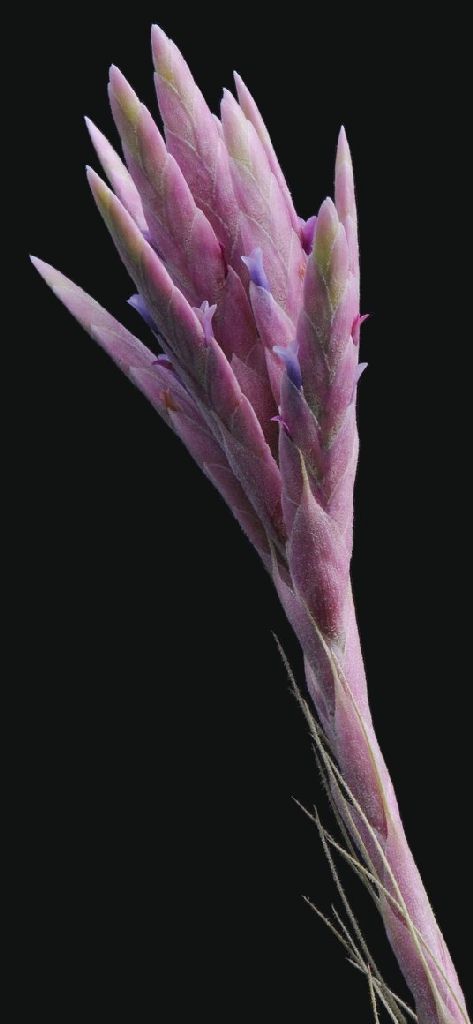
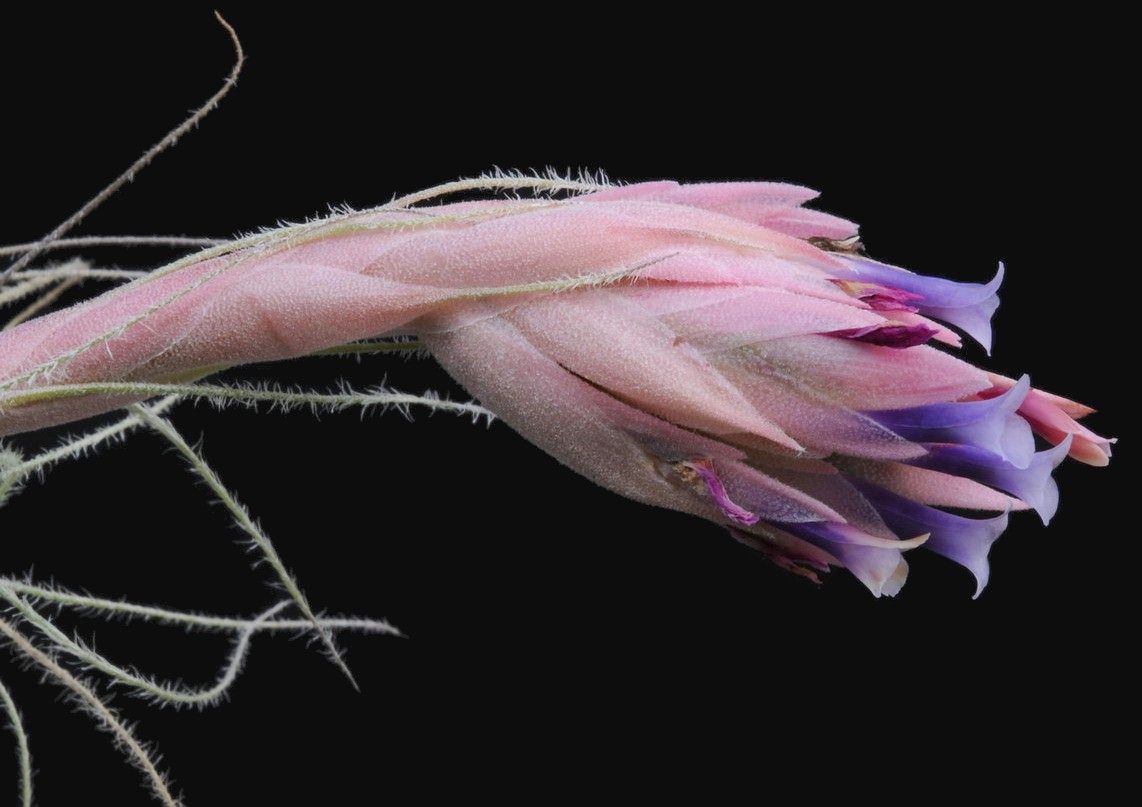
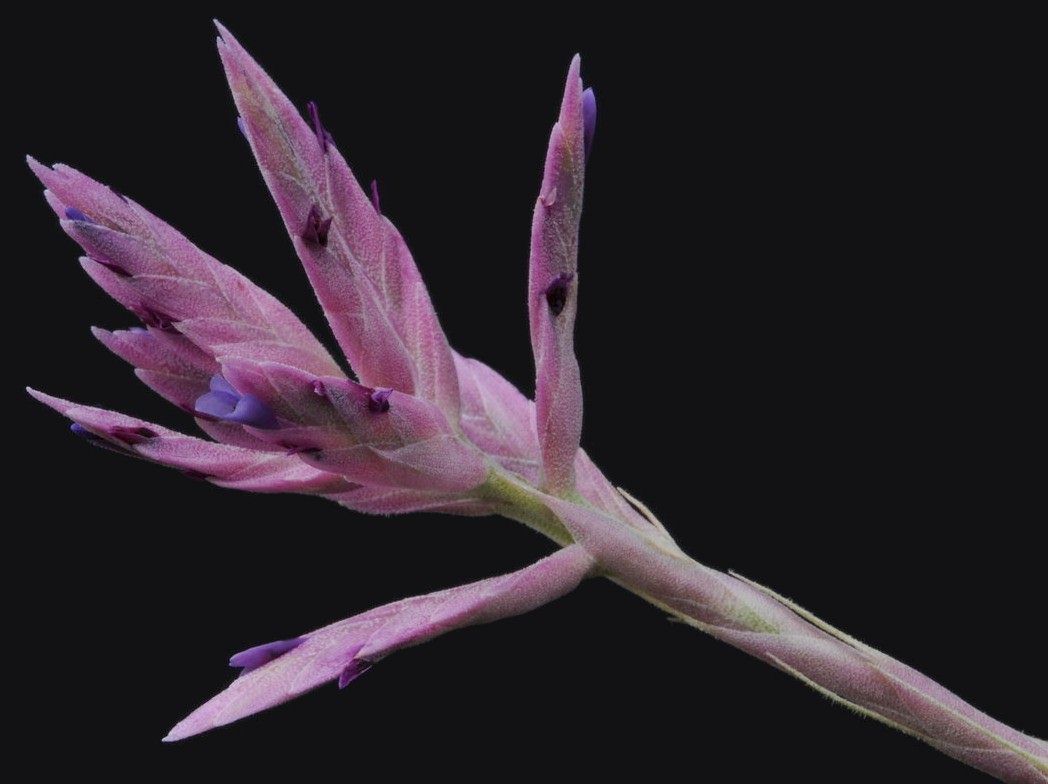
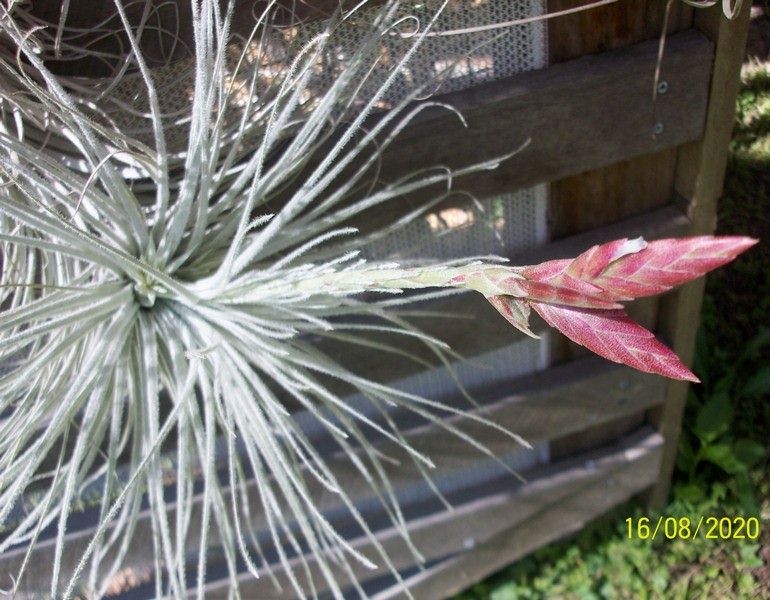
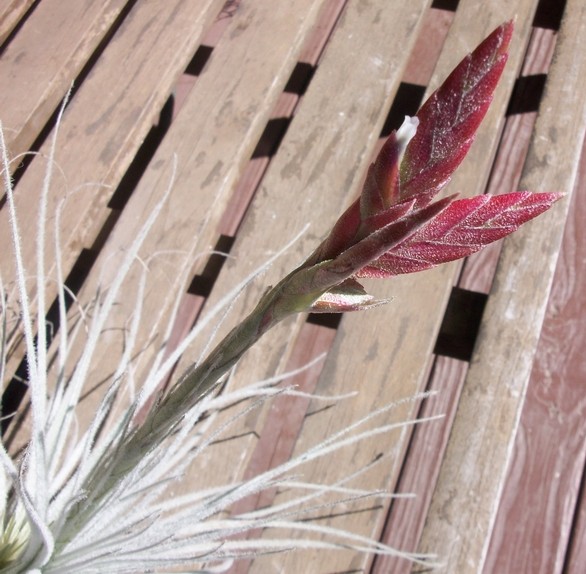
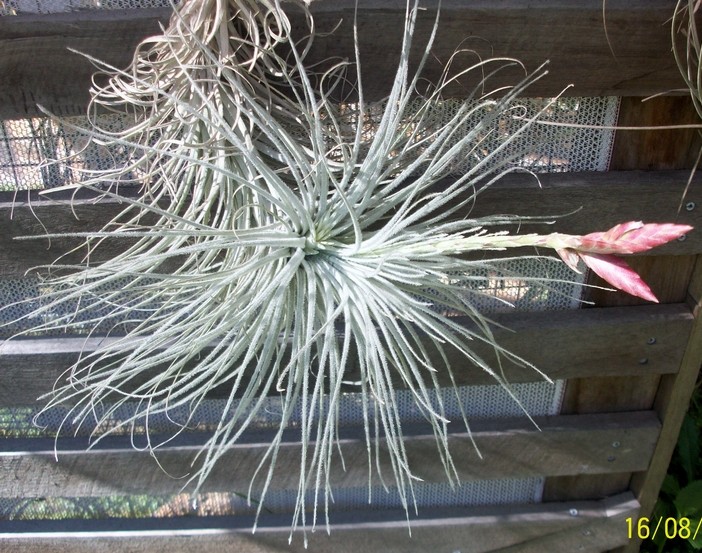
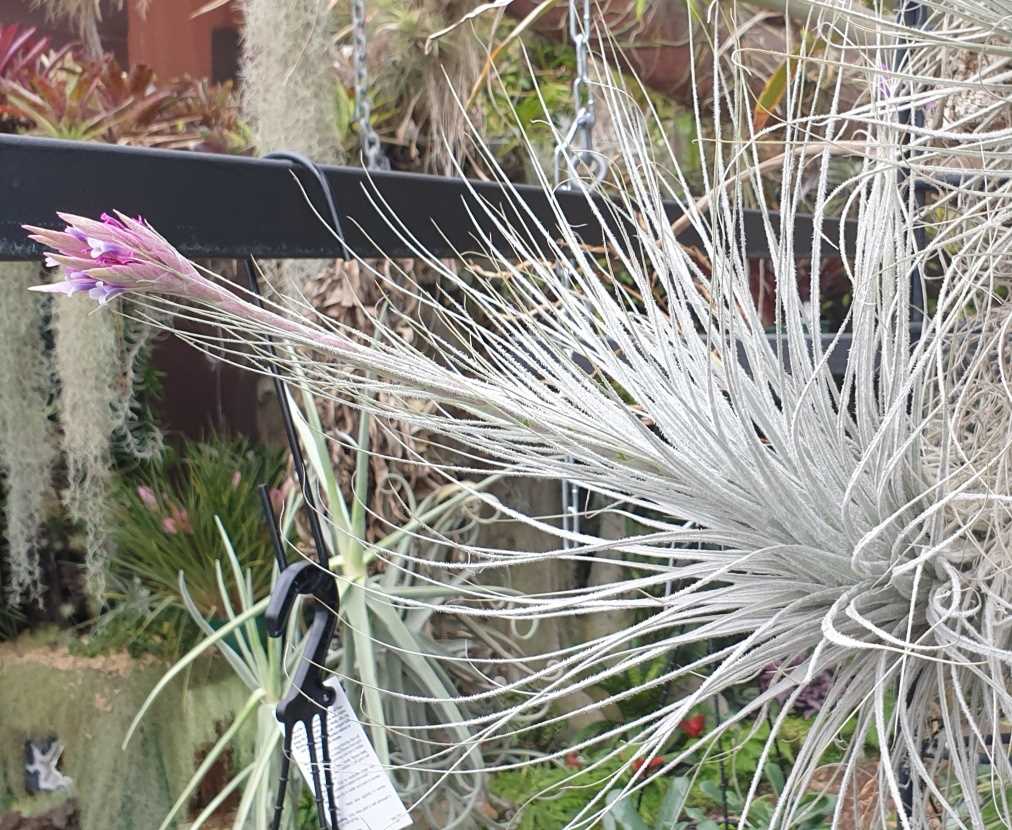
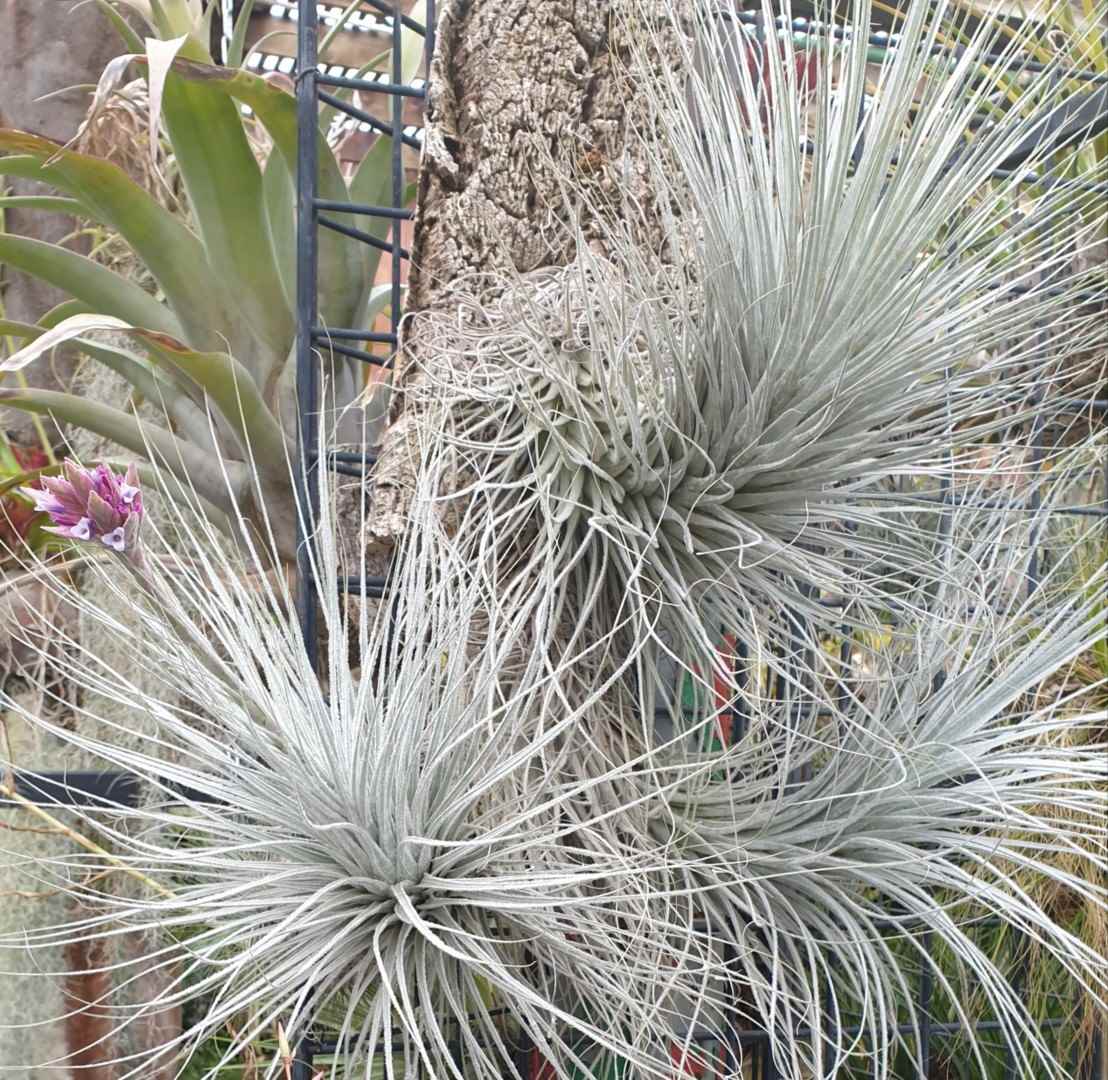
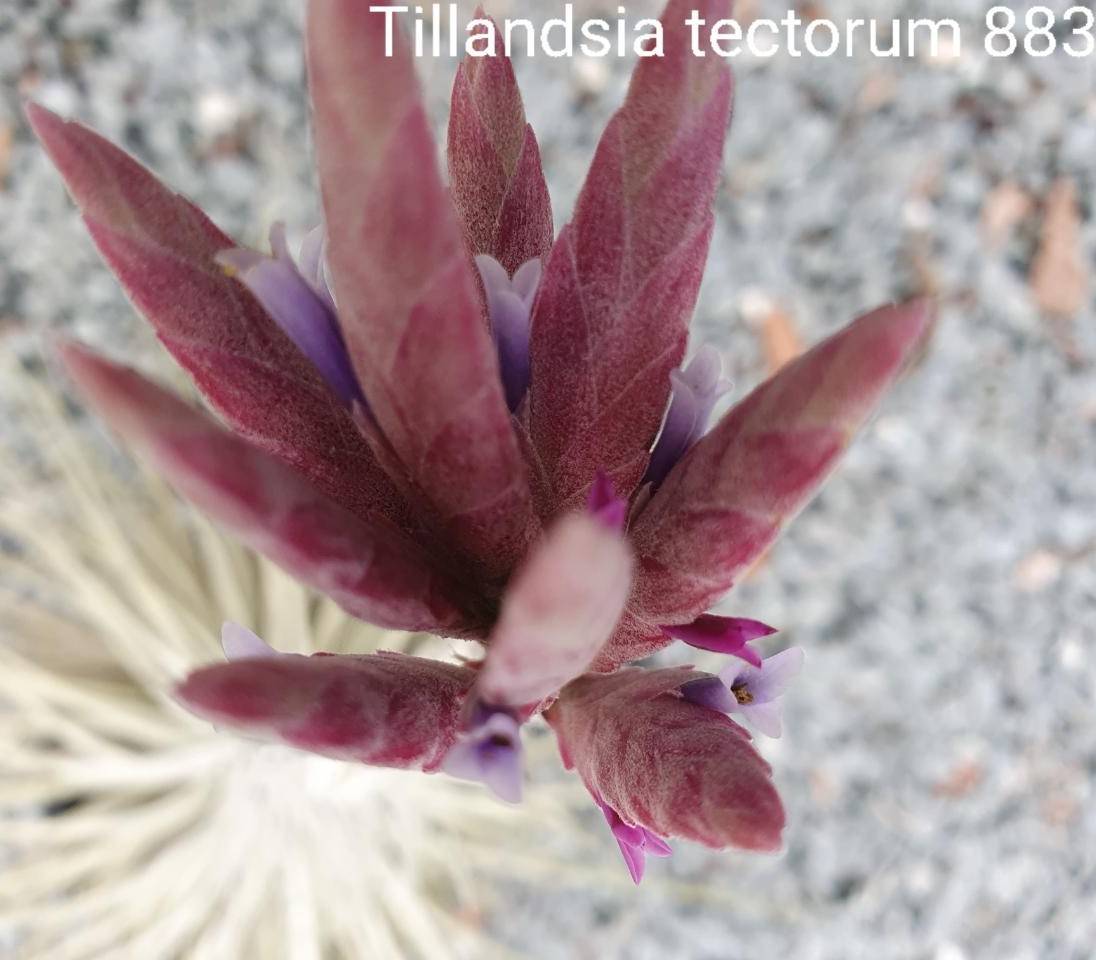
Pam Butler ... "Yet another tectorum in flower. I have had so many flowers this year and now have a lot of seed pods.
Does anyone know how long the seeds take to mature?"
Bob Reilly ... "Hi Pam: Mine seem to mature after 6 months or so here in Brisbane. However, the seed pods often do not change colour before opening, so I do put an open mesh bag over them."
Andrew Flower ... "Over here the tectorums mature in 8-12 months. (I say "tectorums" because thanks to Lotte H. many formerly labelled as "tectorum' have been given new names - the one that matures in 8 months actually keys out to T. oblivata)"
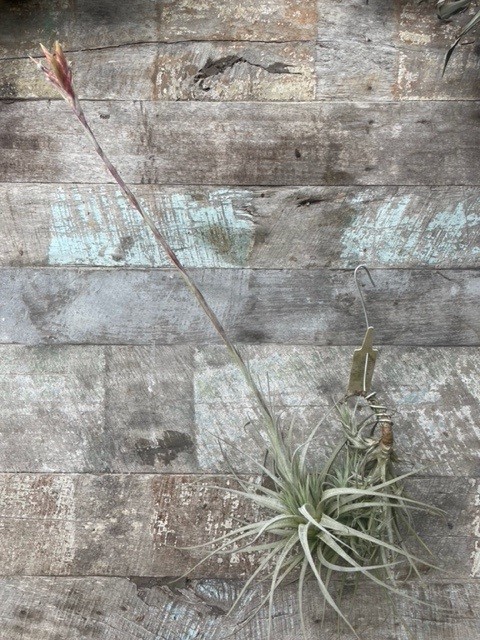
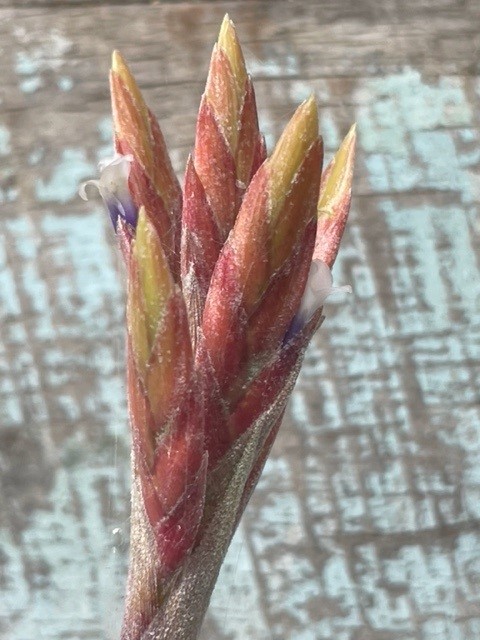
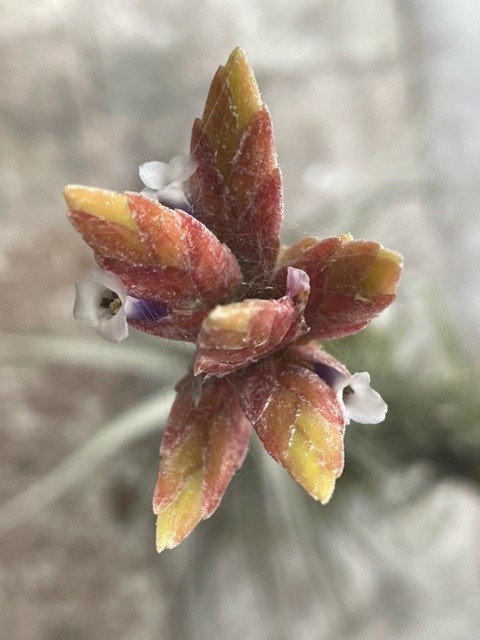
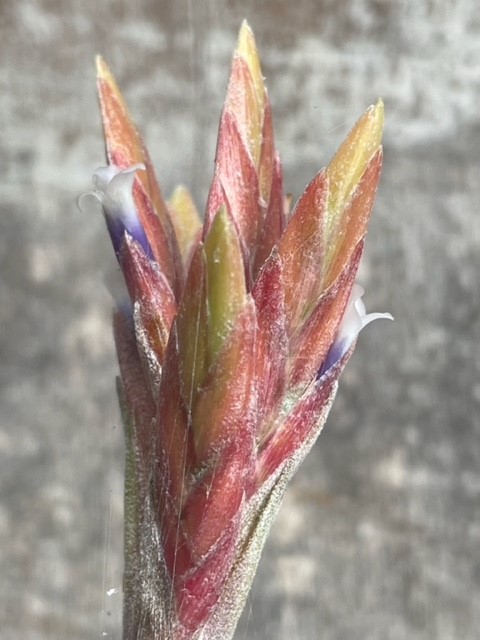
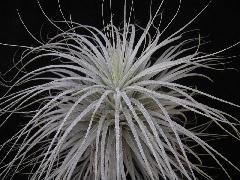
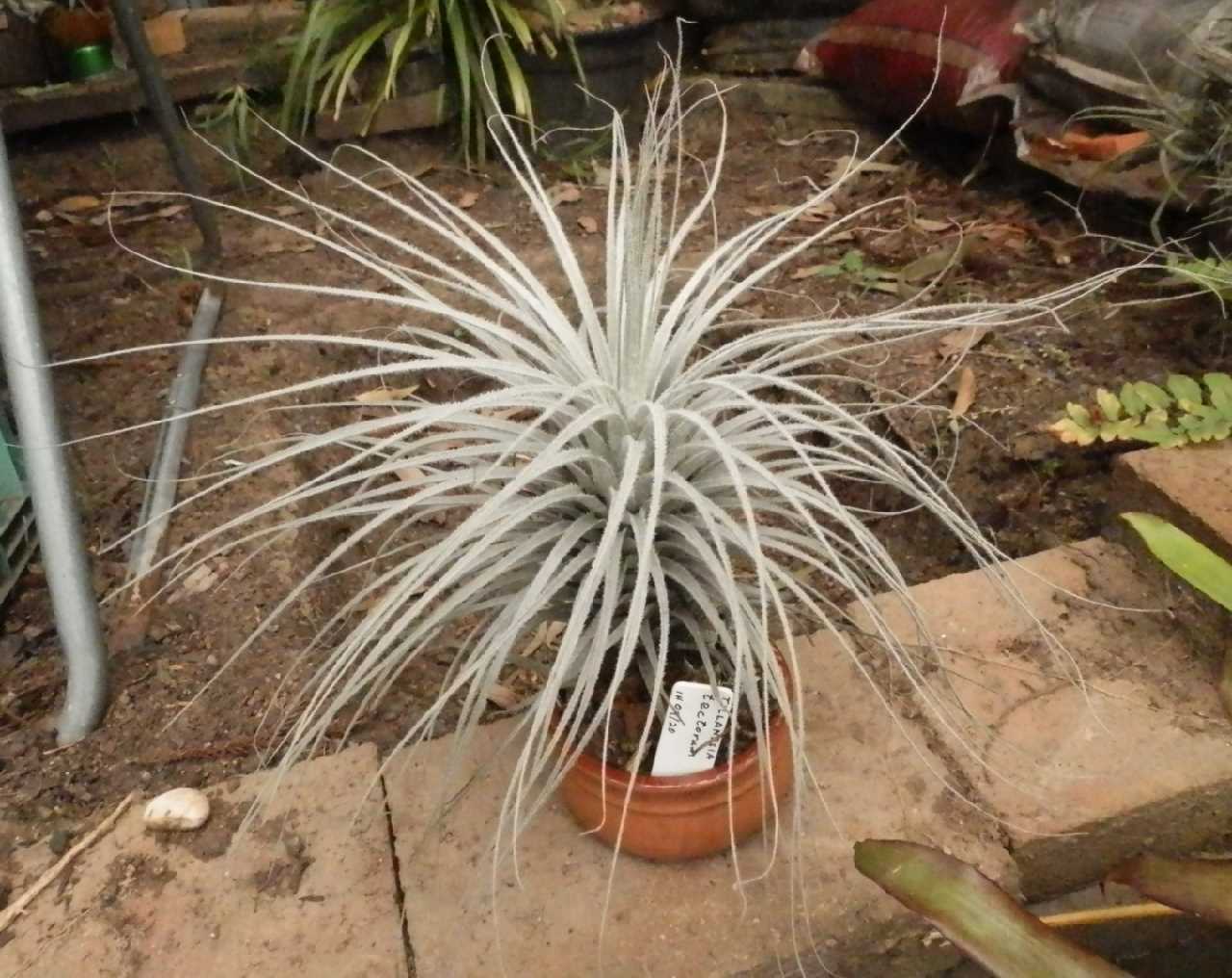
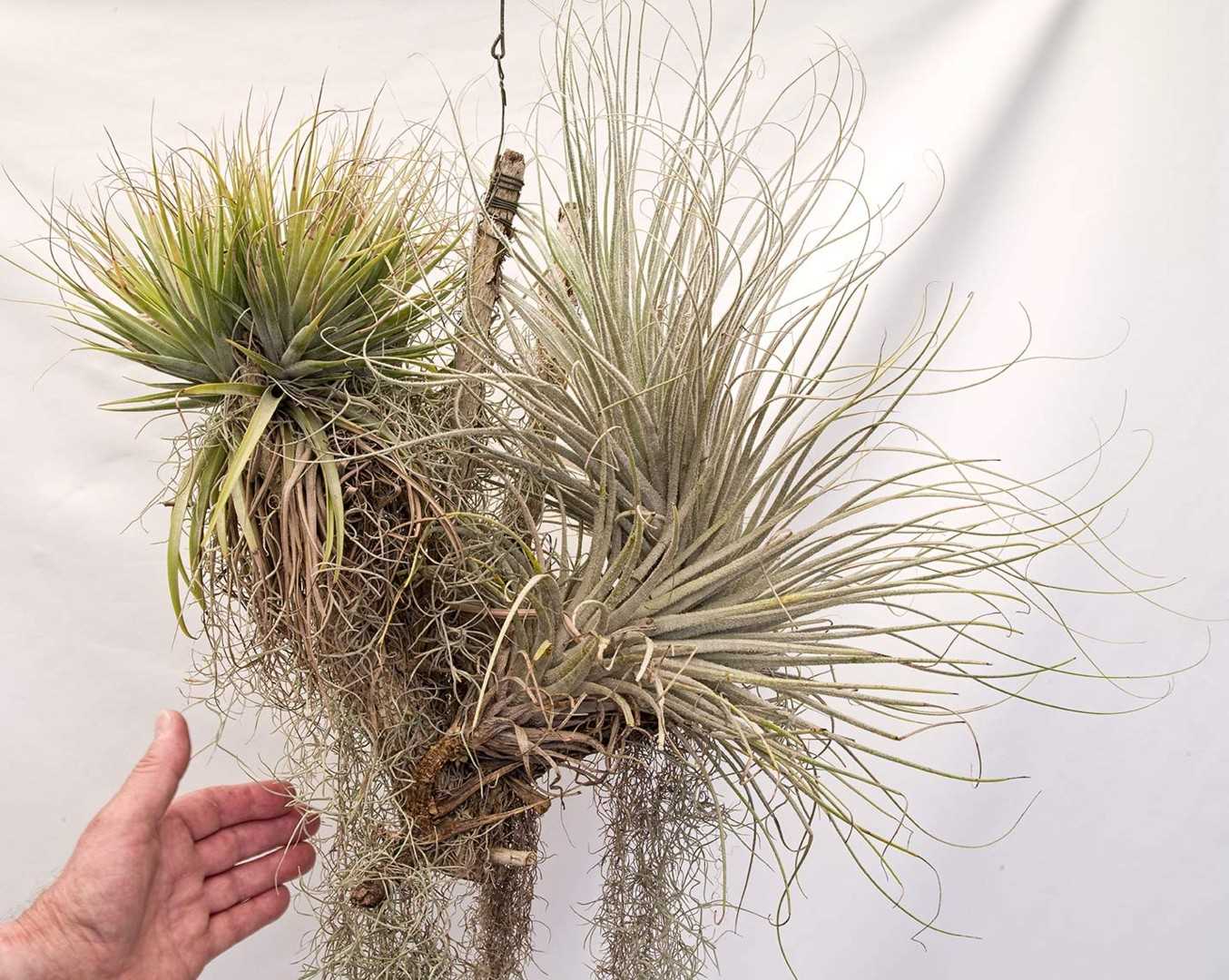
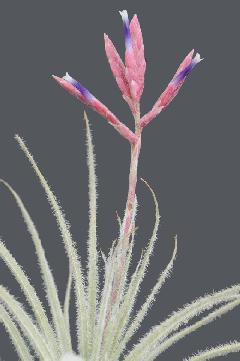
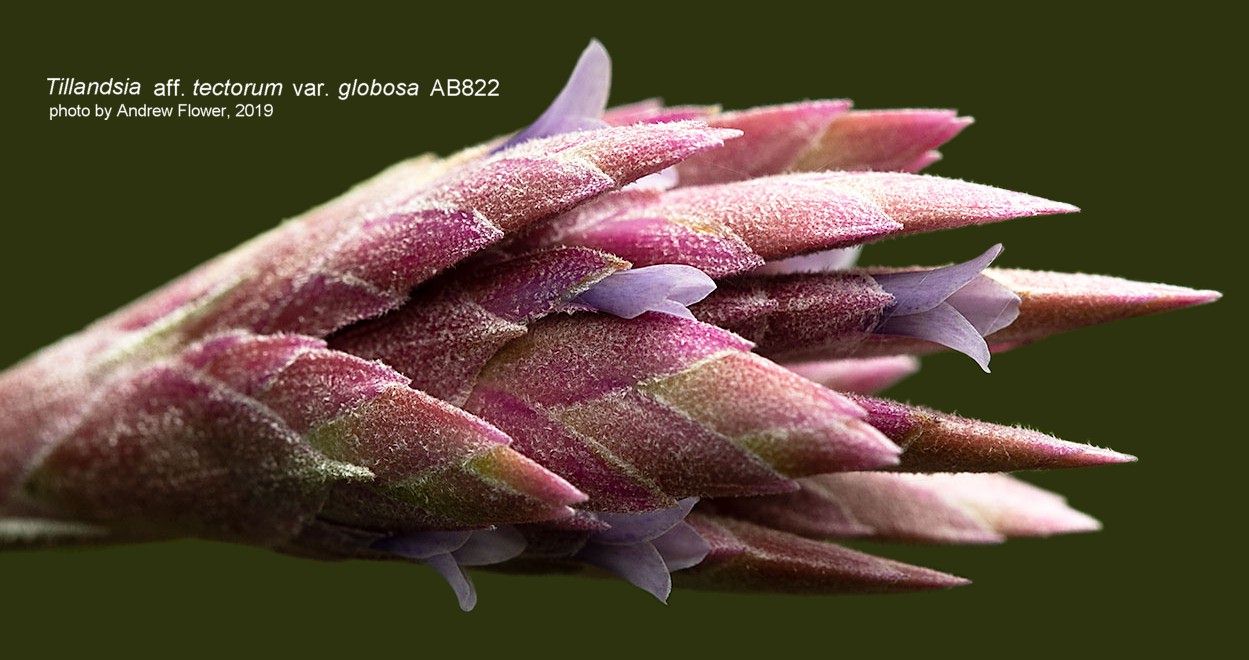
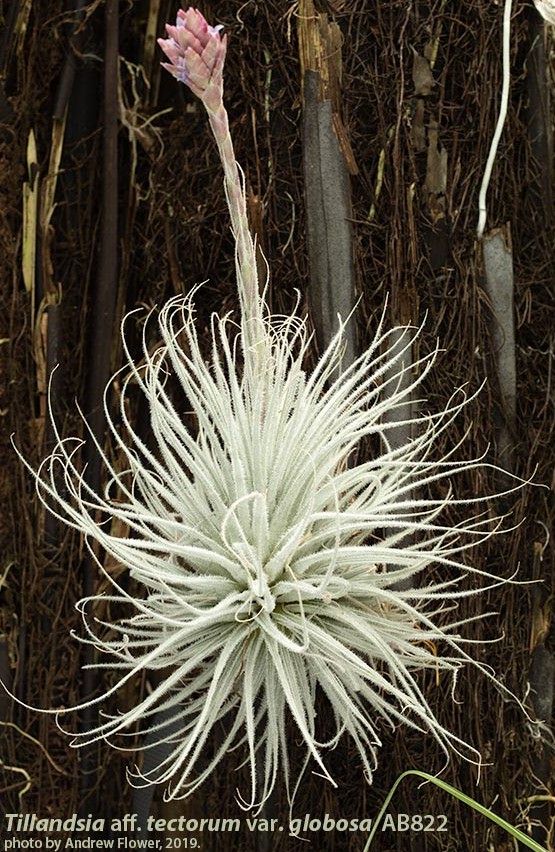
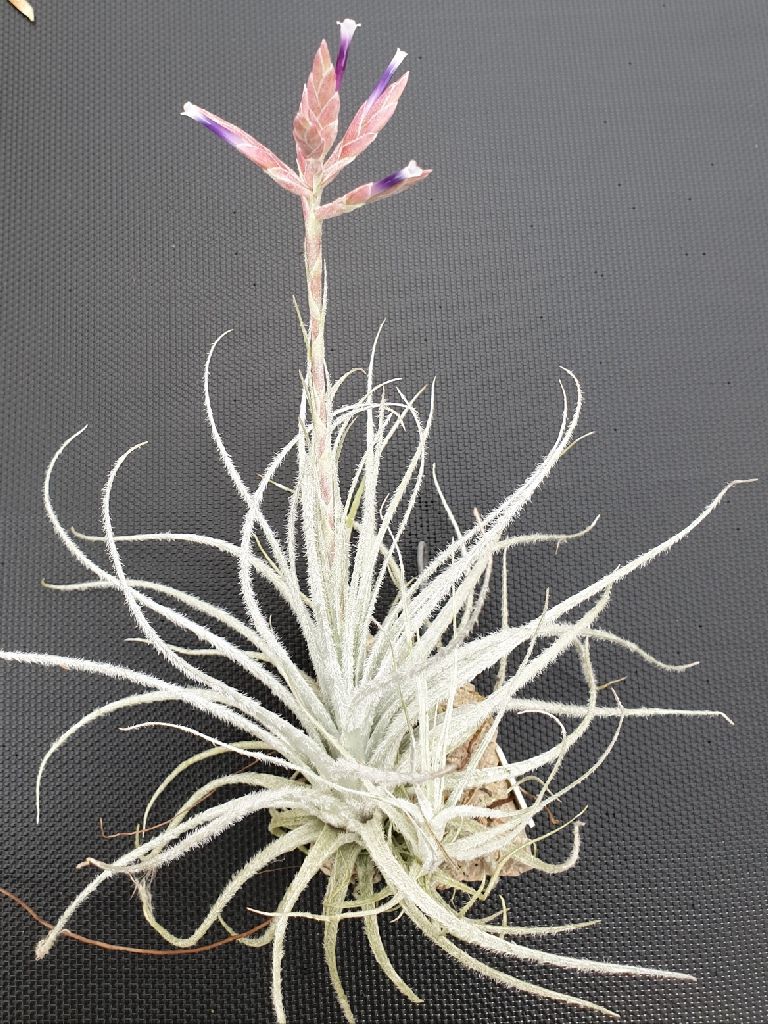
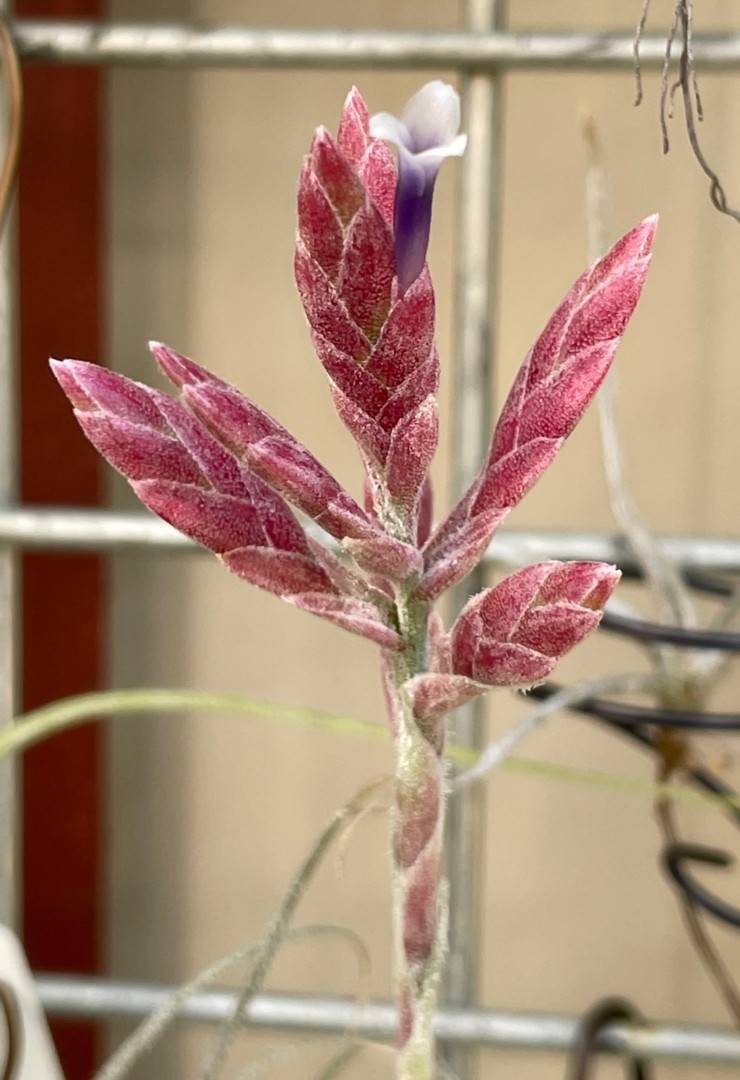
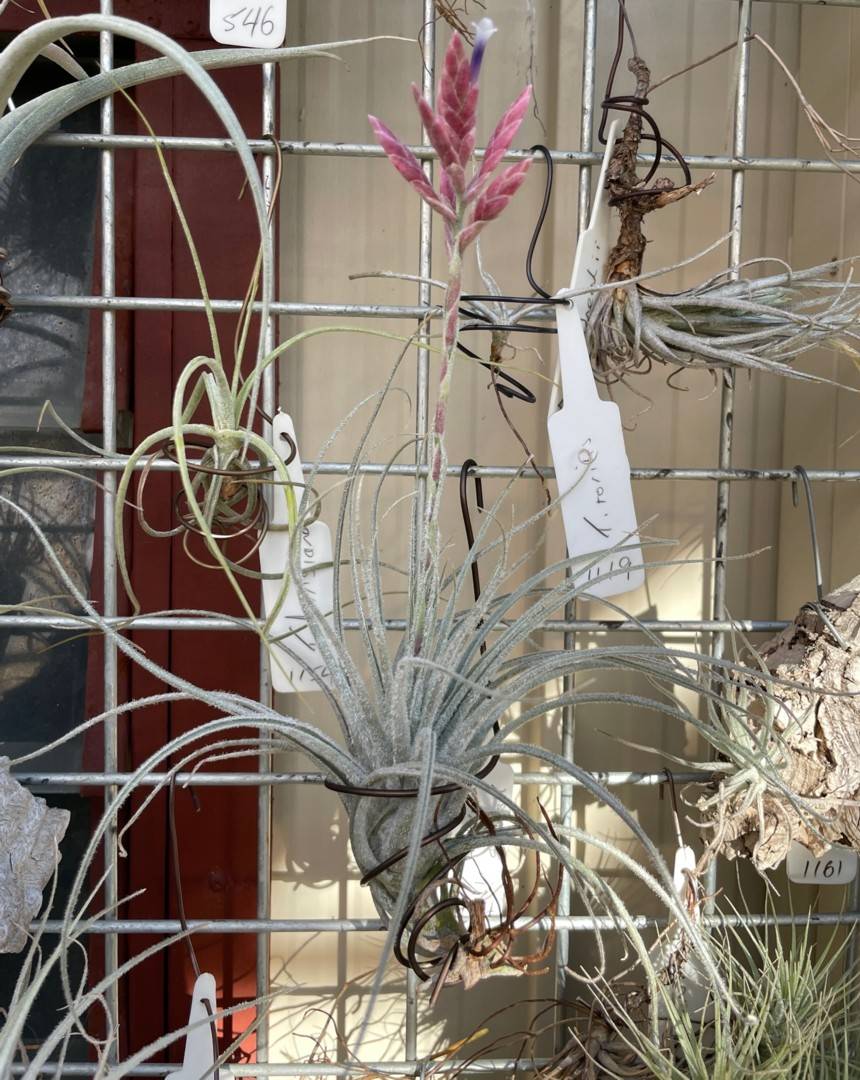
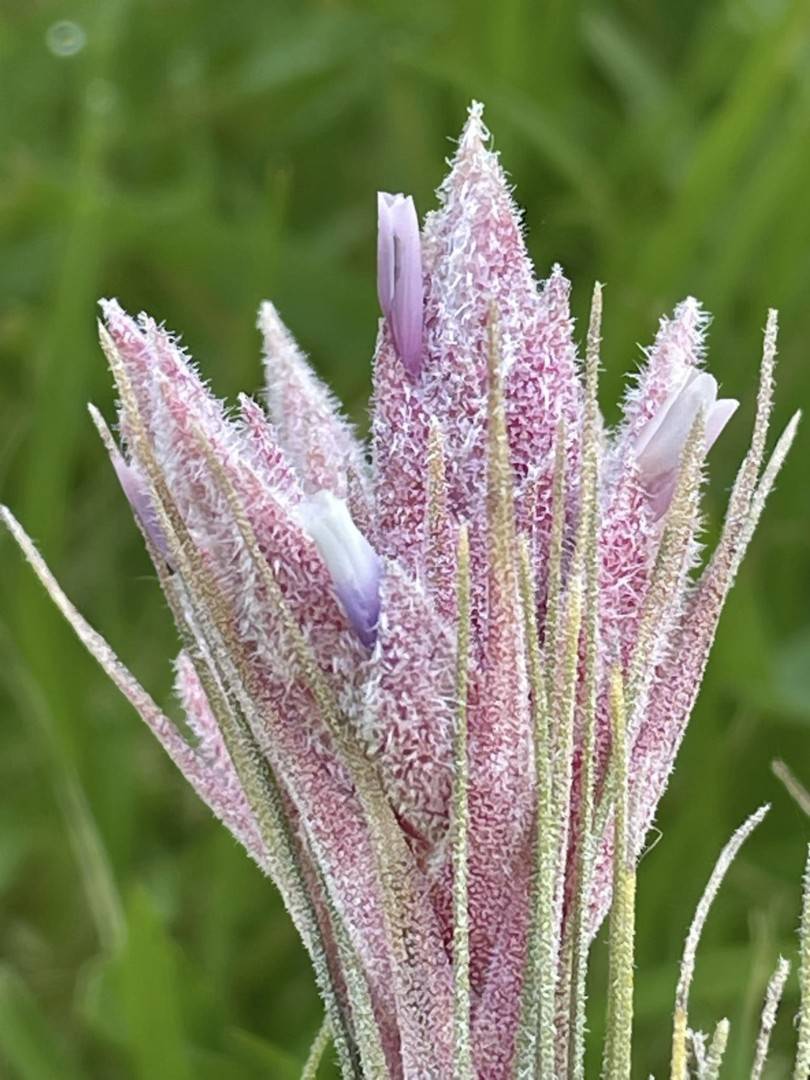
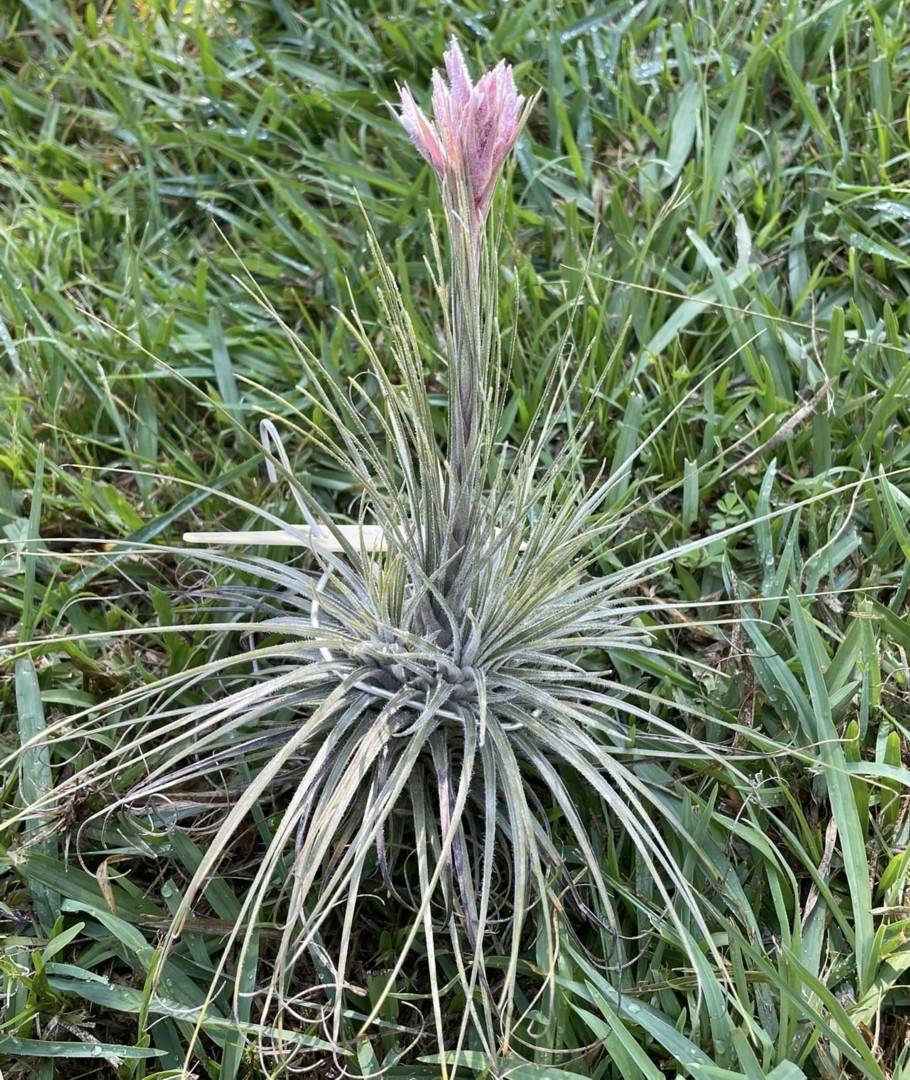
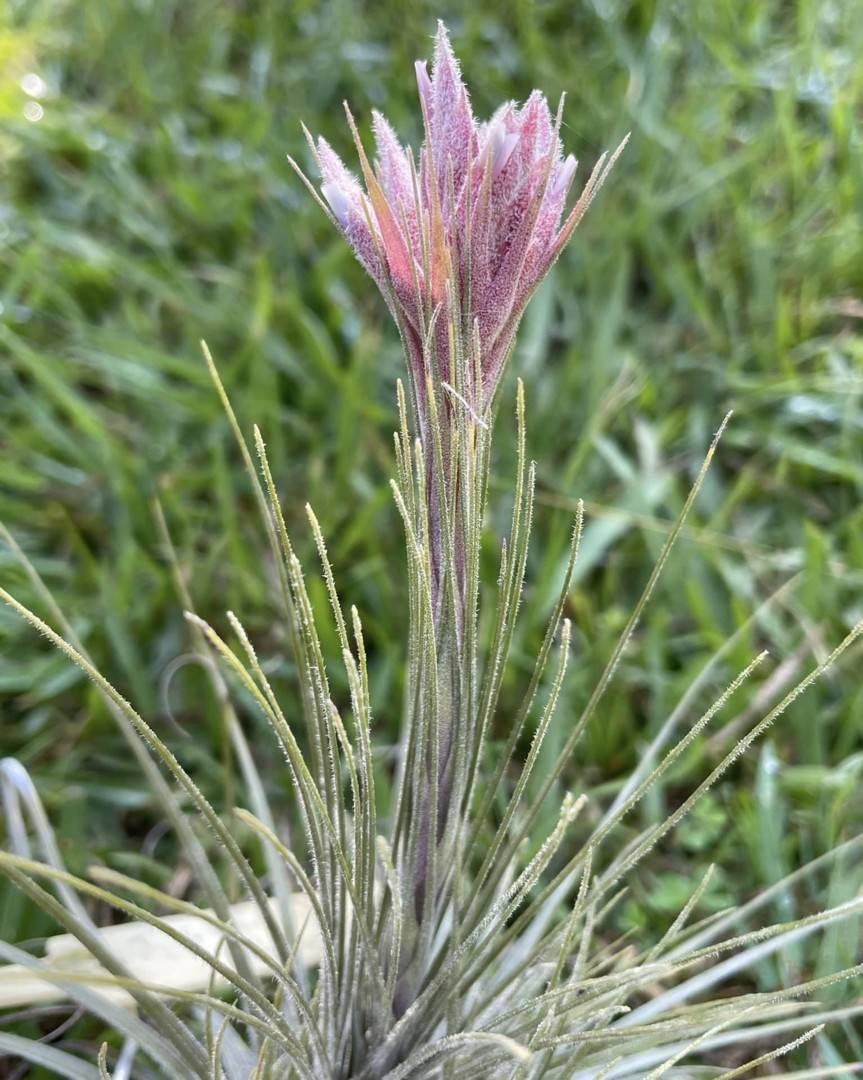
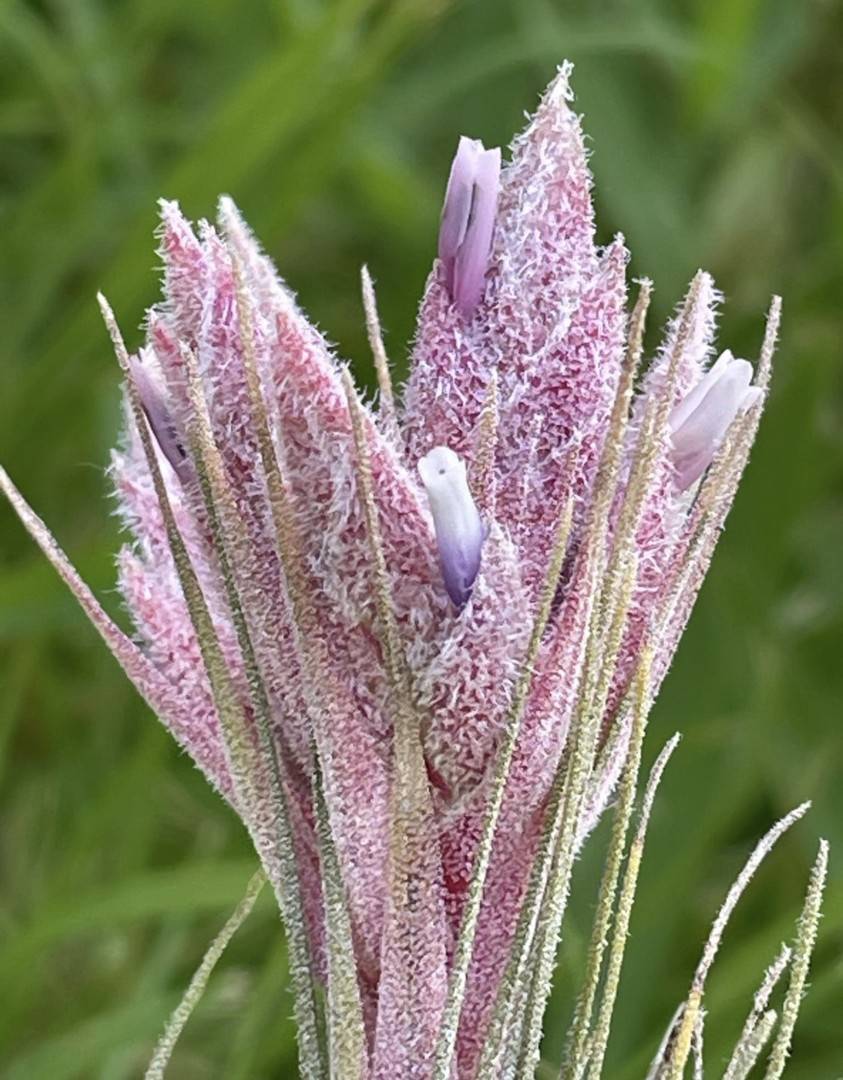
Key to the species of the T. tectorum - family. By Lieselotte Hromadnik in Die Bromelie Sonderheft 5 2005
1. Plant long caulescent => 2
1. Plant stemless or the stem shorter than the leaves => 5
2. Blades densely tomentose covered with long eccentric scales => 3
2. Blades stiff, appearing smooth because of the densely appressed or subappressed scales, inflorescence densely ellipsoid, more or less as long as the leaves => 4
3. Leaves 12-20 mm long, subrectangularly spreading, Inflorescence simple, subsessile, few-flowered => T. stellifera
3. Leaves 12-25 cm long, erect to recurving, inflorescence digitate from some erect to spreading spikes, much longer than the leaves => T. tectorum var. tectorum
4. Leaves 1,5-6 cm long, lower part of the leaves densely appressed to the stem, blades mostly recurved; Ancash, Peru => T. heteromorpha var. heteromorpha
4. Leaves (2-) 6-12 cm long, sheaths more or less spreading, Cajamarca, Peru => T. heteromorpha var. rauhii
5. Leaves appressed lepidote, involute- subulate, erect or recurved, inflorescence much longer than the leaves, subdensely composed from a few erect spikes, or simple => T. lithophila
5. Leaves densely covered with narrow, eccentric scales => 6
6. Inflorescence simple, rarely a second spike => 7
6. Inflorescence compound => 9
7. Blades spreading => 8
7. Blades imbricate, forming a narrow conic tapering rosette, inflorescence shorter than the leaves, rarely digitate with a second spike => T. tomekii
8. Blades to 8 cm long, spreading lepidote, inflorescence longer than the leaves, scape slender, glabrous, spikes to 4 cm long and to 10-flowered, floral bracts glabrous => T. balsasensis
8. Blades to 5 cm long, appressed lepidote, inflorescence shorter than the leaves, scape to 3 cm long, densely spreading lepidote, spike 2 cm long, to 4-flowered, floral bracts lepidote => T. chusgonensis
9. Inflorescence digitate from some spreading, linear-lanceolate spikes, spikes many-flowered, much longer than the primary bracts => 10
9. Inflorescence dense, spikes erect and enfolded by their primary-bracts => 13
10. Plant flowering 30-50 cm high, leaves 15-20 cm long, spikes to 8 cm long, linear-lanceolate many-flowered, strongly complanate, primary bracts not longer than the lowest sterile part of the spike => T. tectorum forma gigantea
10. Plant flowering not over 25 cm high, spikes to 3 cm long => 11
11. Leaves spreading, rosette globose, spikes not smaller than 8 mm, rounded complanate, floral bracts spreading lepidote => 12
11. Leaves erect, somewhat recurved, rosette inverted cone-shaped, spikes complanate, to 2,5 cm long, not more than 7mm wide, style exceeding the tips of the petals => T. oblivata
12. Leaves densely white (like fine needles) lepidote, primary bracts apiculate, half the length of the spikes => T. tectorum var. globosa
12. Leaves subdensely lepidote from scales as fine as a hair, filiform and greenish, the lower primary bracts filiform-attenuate and mostly as long as the tips of the spikes or longer => T. tectorum var. viridula
13. Inflorescence as long as the leaves, primary bracts much longer than the spikes, lower spikes 2-flowered, sepals 8 mm long, petals violet, Ecuador => T. rupicola
13. Inflorescence longer than the leaves => 14
14. Leaves equally spreading, blades scarcely more than 7 cm long, scape and rhachis lepidote, primary bracts as long as the spikes, spikes 1-2-flowered, 2 sterile bracts ad base, floral bracts 12 mm long, lepidote, sepals nerved, petals violet => T. reducta
14. Leaves more or less distinct curling upwards, to 15 cm long, primary bracts shorter than the spikes, spikes 2-6- flowered, scape and rhachis glabrous, floral bracts glabrous, longer than the sepals, sepals even, petals white with a violet band => T. malyi
Tillandsia tectorum E. Morren var. tectorum
Type: Jean Verschaffelt hortus in Gent s. n. (B, destroyed?) as T. argentea K. Koch & J. Verschaff., 1868, nom. illeg., non Griseb., 1866.
Plant caulescent, flowering 30-100 cm high.
Leaves densely imbricate along the stem, polystichous, 12-25 cm long, densely tomen-tose-lepidote;
sheaths amplexicaul, triangu¬lar-ovate, 15-30 mm wide at base, densely lepidote except the inner base, distinct;
blades spreading, 8-15 mm wide next to sheath, very narrow triangular, filiform-attenuate, white to ash-grey, striate.
Scape erect, slender, to 40 cm long, much exceeding the leaves, densely lepidote;
scape-bracts: sheaths imbricate, broadly ovate, 15-25 mm long, 8-12 mm wide, membranaceous, nerved, adaxial scattered lepidote, abaxial densely lepidote, reddish with 1-9 cm long filiform-laminate blade.
Inflorescence 6-10 cm long, 5-8 cm in diameter, densely digitate from about 5 spikes;
primary bracts like the upper scape-bracts, much shorter than the spikes;
spikes sessile, erect, somewhat spreading, lanceolate, 45 mm long, 12 mm wide, complanate, 5-10-flowered;
floral bracts densely imbricate, ovate lanceolate, short tipped acute, 10-17 mm long, 7-11 mm wide, about equaling the sepals, carinate, thin, nerved, soon glabrous, mostly toward the inside of the tip lepidote, red and green or roseate.
Flowers subsessile, 20 mm long;
sepals free, lanceolate, 9-15 mm long, 3-4 mm wide, thin, the posterior carinate, inside glabrous, outside towards the apex and along the midnerves lepidote;
petals tubular-erect, 20-25 mm long, lingulate, uniformly 3 mm wide, tip obtuse and bent outwards, white with a blue band in the middle section;
stamens and pistil of similar length, l2-17 mm long, visible in throat of corolla;
filaments filiform, white, plicate or straight;
anthers 2 mm long, subbasifixed, thin, black, pollen beige;
ovary 2.5-3 mm high, 2 mm in diameter, green,
stigma with very short, somewhat spreading lobes of type I according to Brown & Gilmartin;
capsule a little bit longer than the sepals.
Habitat and range: Southernmost Ecuador: South of the Prov. Loja; North Peru to the latitude of Lima, between 950 and 3400 m elevation.
Material studied: Peru, Ancash: Rio Fortaleza, 1450 m, 10.08.1976, H. & L. Hromadnik HR 2057 (WU); 4 km N Recuay, 3350 m, W. & S. Till & C. Lindner 2018 (WU); S Chuchajirca, between Huaraz and Casma, 2000 m, E. Vitek 260782/19-1 (WU); Rio Santa, km 181 NW Huaraz, 3400 m, together with Trichocereus santaensis, O. Irrnstorfer nr. 53 ("T. saxicola", WU); Cajamarca: Rio Moche, 950 m, 13.08.1976, K & L. Hromadnik HR 2081 (WU); Rio Moche, 2300 m, 13.08.1976, H. & L. Hromadnik HR 2094 (WU); north. San Marcos, 2500 m, 15.08.1976, H. & L. Hromadnik HR 2104 (WU); Llacanora, km 6 south. Cajamarca, 2600 m, 06.03.1997, H. & L. Hromadnik HR 23087 (WU); N Huayobamba/S.Marcos, 2600 m, 07.03.1997, H. & L. Hromadnik HR 23103 (WU).
Lima: R. Chillon, 2000 m, 19.03.1997, H. & L. Hromadnik HR 23191.
Tillandsia tectorum var. globosa L. Hrom., var. nov.
A varietate typica caule perbrevi, habitu fere globoso et spicis perbrevibus differt.
Type : Ecuador, Dept. Loja: southwest of Catacocha, 1100 m s. m., 21.07.1978, H. & L. Hro¬madnik HR 4130 (holo QCNE, iso WU).
Paratypes: Ecuador, Dept. Loja: W La Toma, 1850 m. 11.07.1978, H. & L. Hromadnik HR 4040 (WU); on the way from Loja to Yangana, 2100 m, H. & L. Hromadnik HR 17128 (WU). Peru, Amazonas: Rio Utcubamba, 1700 m, 18.08.1976, H. & L. Hromadnik HR 2131(WU); Rio Utcubamba, Churuja, 1400 m, 18.08.1976, H. & L. Hromadnik HR 2134 (WU); l.c., 27.07.1978, H. & L. Hromadnik HR 4179 (WU); Cajamarca: wooded slopes in the Rio Chamaya-Valley, 700 m, 26.02.1997, H. & L. Hromadnik HR 23 029 (WU).
Plant stemless to very short caulescent, flowering to 25 cm high; rosette subglobose.
Leaves 15-20 cm long,
sheaths densely imbricate, triangular, 15 mm wide at base and lepidote except for 5 mm towards the base;
blades erect to spreading, rigid, underneath concave, top weakly grooved with a keel along the middle, 6-8 mm wide, very narrow triangular, tapering to filiform-attenuate, densely white eccentric tomentose-lepidote, especially beneath and along the margins.
Scape mostly somewhat longer than the leaves, 2 mm in diameter, densely lepidote, reddish-green;
scape-bracts densely imbricate, sheaths oval, 15 mm long, 6-8 mm wide, smooth, outside densely lepidote, inside glabrous, the lower ones to 6 cm long blades the upper ones shorter.
Inflorescence 3.5 cm high, 3.5 cm in diameter, densely digitate from 5-6 spreading spikes;
axis 2 mm in diameter, densely lepidote, green to red, internodes 1-3 mm long;
primary bracts 10-12 mm long, ovoid, abaxially densely lepidote, somewhat nerved, rose, adaxially glabrous, half as long as the spike and enfolding the lower part;
spikes subsessile, to 25 mm long, 8 mm wide, rounded complanate, 6-8-flowered with two narrow sterile bracts at base;
rhachis four-angular, excavated, densely lepidote, nearly straight, internodes 3 mm long,
floral bracts densely imbricate, 10 mm long, 8 mm at base, broadly oval, acuminate, carinate towards the apex, subdensely and spreading lepidote, nerved, rose;
flowers sessile, erect, 19 mm long;
sepals lanceolate, 9 mm long, 3 mm wide, equally very short connate, thin, smooth at anthesis, outside lepidote along the middle, the posterior carinate;
petals narrow lingulate, 17 mm long, 3 mm wide, tip obtuse, bent outwards, white with a broad violet band in the middle section;
stamens 14 mm long, filaments straight, white, filiform; anthers 3 mm long, thin, subbasifixed, black, pollen beige; pistil 13 mm long, elliptic, green,
ovary 3 mm high, broad-oval, green, stigma small, lobes a little spreading.
Habitat and range: Until now, this variety was only found in the arid areas of South Ecuador and in the inner Andean dry valleys of Peru at elevations of 700-2100 m. Various populations with minor differences in habit grow only in small areas. T. tectorum var. globosa grows almost exclusively as a lithophyte and, as portrayed, on steep, exposed rock walls.
These caulescent plants are easily distinguishable from those with compact growth. The rosettes of these plants are either completely stemless or they produce only a short, stocky stem with age. Most of the stemless forms are relatively small and hardly reach 25 cm in height when flowering. Several of these local forms can be grouped together despite some differences and described as a separate variety based on their virtually spherical rosettes (globosus = spherical).
The spherical rosettes always consist of white, very densely scaled leaves, similar to the rare form (HR 23029) that grows as an epiphyte at about 700 m together with T. disticha Kunth and T. cacticola L.B. Sm. in the dry forest near the Rio Chamaya in the Department of Cajamarca.
A form with a stemless rosette with shiny white scales (HR 17128) was also found to the south of the city Loja in a moderately moist climate on vertical, eroded, sunbaked conglomerate towers.
The most extremely scaled form, however, is only known from the Rio Utcubamba valley in the Department of Amazonas. There, it populates huge, smooth and almost vertical rock walls. Not only are the leaves dense with up to 5 mm long, needle-like scales but the inflorescence, which is somewhat distinct from other forms, has very short, stocky spikes (HR 2131, HR 2134 and HR 4179).
T. tectorum var. viridula L. Hrom., var. nov.
A varietate typica foliis et inflorescentiis viridulis, foliis perangustis et spicis floribusque minoribus differt.
Type: Peru, Amazonas: South of Chachapoyas, 2 100 m s. m., 27.07.1978, H. & L. Hromadnik HR 4181 (holo USM, iso WU).
Paratype: 1. c., 02.03.1997, K & L. Hromadnik HR 23054 (WU).
Plant growing as an epiphyte, stemless, flowering to 20 cm high; all parts except for petals somewhat greenish
Leaves narrower at the base than the other varieties, forming a globular rosette, to 14 cm long, very soft;
sheaths triangular-ovate, 10 mm wide at base, 20 mm long, thin, nerved, outside and inside densely lepidote;
blades distinct from sheath, 4 mm wide at base, greenish striate, tapering to filiform in the upper one third, scales long and as fine as a hair.
Scape exceeding the leaves, 2 mm in diameter;
scape-bracts sheaths densely imbricate and somewhat inflated, 15 mm long, 6 mm wide, oblong-elliptic, nerved, lepidote, pale greenish, blades filiform to 7 cm and equalling or exceeding the spikes.
Inflorescence densely digitate from 5-6 erect spikes, 3.5 cm long, 3 cm wide;
primary bracts: sheath thin, nerved, lepidote, outside flaky lepidote, the sheaths half as long as the spikes, but blades long filiform and mostly exceeding the top of the spikes; spikes subsessile, short lanceolate, complanate, 4-5-flowered, 2 sterile bracts at base; rhachis lepidote;
floral bracts 15 mm long, 8 mm wide, acuminate-ovate, thin, nerved, carinate, inside glabrous, outside densely lepidote with fine linear spreading scales.
Flowers 17 mm long, subsessile;
sepals 10 mm long, 5 mm wide, acute-ovate, the posterior ones carinate and connate for 2 mm, thin, greenish-white, the top abaxially hairy lepidote;
petals 18 mm long, 3 mm wide, lingulate, obtuse, white with a broad violet band, tip bent outwards;
stamens and pistil 11 mm long, filaments white, straight, filiform, anthers 3 mm long, 0.5 mm wide, subbasifixed, black, pollen beige;
ovary pale green, subglobose, 2.5 mm in diameter, stigma punctulate.
Habitat and range: Until now, this pretty, small plant was only known from the vicinity of the city Chachapoyas. It grows exclusively as an epiphyte at 1400-2100 m and in a much moister climate than otherwise expected for T. tectorum. Its companion plants were an exceptionally large-scaled, small form of T. humilis C. Presl and T. tovarensis Mez, both typical inhabitants of moist and cool altitudes.
T. tectorum var. viridula is another stemless local form, that differs in some characteristics from the aforementioned variety. It seems to be restricted to a relatively small area near the city Chachapoyas, Department of Amazonas.
These plants have almost thread-thin, greenish leaves and, therefore, fragile-looking rosettes. The scales are very finely hair-like. This plant merits the status of variety and is named for its uncommon greenish colouring. The characteristics of this variety, apart from the greenish colouring of the leaves and inflorescence, include: the very narrow leaf sheath and blade; the long scape bracts and the flaky lepidote primary bracts, that with their foliate blades exceed the top of the spikes; spikes only 4-5-flowered, floral bracts covered with long fine needle-like scales on the outside; flowers only 17 mm long, sepals only 10 mm long, but oval acuminate and 5 mm wide (not lanceolate), the posterior pair not free (connate for 2 mm), greenish white and hairy lepidote on the outside at the tip (not only scaled along the mid-vein).
Tillandsia tectorum forma gigantea L. Hrom., fo. nov.
A forma typica habitu permajore, foliis validis et spicis perlongis differt.
Type: Ecuador, Azuay: Ona, rocks in the valley of Rio Leon, 2000 m s. m., 25.12.1992, H. & L. Hromadnik HR 17103 (holo QCNE, iso WU).
Paratypes: 1. c., 2 100 m, 25.12.1992, H. & L. Hromadnik HR 17102a (WU); Giron: km 46 W Giron, 1650 m s.m., H. & L. Hromadnik HR 17055 (WU); Loja, 110 km S Cuenca, 2400 m, 13.07.1978, H. & L. Hromadnik HR 4077 (WU).
Plant flowering to 40-50 cm high, stemless or short caulescent, stem shorter than the leaves, forming a compact rosette to 40 cm diam.
Leaves to 20 cm long, densely white eccentric tomentose-lepidote especially beneath and along the margins;
sheaths densely imbricate, triangular, 1 cm long, 3 cm wide at base, densely lepidote except the base;
blades very narrowly triangular, filiform-attenuate, 15 mm wide at base, rigid, on the upper side 2-3 long ridges, erect to spreading.
Scape 30 cm high, 5 mm thick, green, upper part lepidote, just a minor part visible;
scape-bracts sheaths 2-2.5 cm long, 1-1.4 cm wide, ovate, thin-membranaceous, nerved, inside and outside lepidote, purple-roseate, bearing a thin filiform blade, 10 cm (basal) to 2.5 cm (apical) long.
Inflorescence much longer than the leaves, digitately compound from 6-10 spreading linear spikes, to 12 cm long and 10 cm in diameter;
primary bracts like the upper scape bracts, but only the apex adaxially lepidote, the lowest bearing a blade of 1 cm length, enfolding only the sterile part of the spikes;
spikes short stipitate, to 8 cm long, 12 mm wide, complanate, to 20-flowered, 2-3 sterile bracts towards the base;
rhachis densely lepidote, 4-angular, excavated, slightly flexuous, internodes 5-3 mm; floral bracts densely imbricate, 17 mm long, 11 mm wide, acute ovoid, nerved, carinate, lepidote only outside, rose.
Flowers subsessile, 25 mm long;
sepals 15 mm long, 4 mm wide, acutely lanceolate, nerved, the posterior carinate and connate for 1 mm, lepidote only outside along the midvein;
petals tubular-erect, oblanceolate, 22 mm long, claw 2 mm wide, plate elliptic, 3 mm wide, the lower part violet, plate white with a blue band, or completely violet and changing colour to purple when fading, apex acute, somewhat spreading;
stamens and pistil 18 mm long, filaments white, filiform, straight; anthers 2.5 mm long, thin, basifixed, black, pollen dull yellowish-brown;
ovary ovate, 3 mm long, 2 mm in diameter, yellowish green; stigma corresponds to type I of Brown & Gilmartin, lobes suberect.
Habitat and range: This beautiful, large form populates extended stands in the dry valleys of the Rio Negro, Rio Leon and Rio Jubones at an altitude between 1500 and 2400 m. It is too moist for xerophytic plants above and below this altitude.
Because of its spherical rosettes, this variety has the showiest appearance of the group. For a long time, it was known as the big 'Ecuador form', also recently called T. tectorum fo. gigantea by dealers. Because the name seems to be established and the plant is already known under this name, it should remain and is described here as such.
Because it forms several offsets after flowering, T. tectorum fo. gigantea often grows in large groups. One-meter wide, almost hemispherical cushions or dense, flattened extended mats can be formed on rocks and on precipitous rubble surfaces. On the stony slopes, the stands grow together with a large cushion form of T. disticha Kunth and with T. mima L.B. Sm.
The most outstanding characteristics of this compact and very short-stemmed form are the size of the rosette, the strong leaves, and the inflorescence with its extraordinary long, linear, strongly complanate and extended spikes, from which up to 20 flowers grow; the floral bracts and the pointed sepals are larger than in the other forms.
For more than 20 years, enormous quantities of this beautiful plant have been exported to Europe, sometimes even in big packages labeled 'dried plants for decoration'. Luckily, the populations in the few dry valleys in the provinces of Azuay and Loja in southern Ecuador, that are suitable as habitat for xerophytic plants, are so extensive that no serious damage has yet occurred.
Tillandsia tectorum E. Morren. Belg. Hortic. 27: 328, pl. 18. 1877; nom. nov.
Tillandsia argentea sensu K. Koch, Cat. Verschaff. 4.1867; Wochenschr. Gartn. 11: 161.1868; non Grisebach, 1866.
Pourretia nivosa hortus ex E. Morren. Belg. Hortic. 27: 328. 1877; nomen in synon.
Tillandsia rupicola Baker, Jour. Bot. London 26: 13. 1888.
Tillandsia saxicola Mez, Repert. Nov. Sp. 3: 41. 1906. Type. Huaraz to Carhuaz. Ancachs, Peru. Weberbauer 3290 (B, F photo 11524), 22 Jun 1903.
Desc from S&D p786 &865 for T. rupicola whose description is in brackets
Plant caulescent, flowering 3-5 dm long. (flowering to 9 cm high)
Leaves densely imbricate along the stem, polystichous, 2 dm long, densely tomentose-lepidote; (many, densely polystichous, 6 cm long, covered with very large spreading linear sub ferruginous scales;)
Sheaths distinct, triangular-ovate; (triangular , merging with the blades;)
Blades spreading, linear, filiform-attenuate, 4 mm wide, cinereous. (spreading to recurved, involute-subulate.)
Scape erect, much exceeding the leaves, slender; (shorter than the leaves;)
Scape-bracts imbricate, involute, broadly ovate, filiform-laminate, reddish. (ovate-elliptic, puberulous, foliaceous-laminate.)
Inflorescence densely digitate from about 5 spikes; (depauperate compound, ellipsoid, 16-24 mm long, 9-10 mm in diameter;)
Primary bracts like the scape-bracts, much shorter than the spikes; (densely imbricate, elliptic, caudate;)
Spikes sessile, lanceolate, 45 mm long, 12 mm wide, complanate, densely 7-flowered. (1-flowered.)
Floral bracts imbricate, lanceolate, acute, about equaling the sepals, carinate, thin, nerved, soon glabrous, red and green or roseate (acute, to 12 mm long, exceeding the sepals, chartaceous, nerved, covered with subspreading ferruginous scales.)
Sepals free, lanceolate, 10 mm long, the posterior carinate;
Petals tubular-erect, 20-25 mm long, white with a blue band below the apex; (violet; blade 3 mm long)
Stamens included; filaments plicate; style elongate.
Type. Wallis in Linden Hortus s n (BR ? n v ), without exact locality, Peru, 1865-66. In the absence of any specimen, the species is well typified by Morren's description and plate.
DISTRIBUTION. Saxicolous and cultivated on roofs, 980-2700 m alt, Ecuador and northern Peru.
ECUADOR. AZUAY: Rio Leon to Rio Ona, 3 Aug 1943, Steyermark 53731 (F, GH, US); Ona Valley, km 90-110, Cuenca to Loja, 3 Dec 1948, Foster 2616 (US); 12 Aug 1965, Gilmartin 1156 (US). PERU. CAJAMARCA: Llacanora, 7 Mar 1965, Sanchez 58 (US); Hacienda La Colpa, 5 Oct 1965, Sanchez 121 (US). LIBERTAD: Samne to Casmiche, Otuzco, 21 May 1952, Lopez 4806 ('IRP); Hacienda Yanazara, Huamachuco, 25 Jun 1958, Lopez & Sagastegui 2772 (TRP, US); Poroto, Trujillo to Huamachuco, 5 Aug. 1964, Hutchison & Wright 6118 (F, UC, US, USM). ANCACHS: Huaraz, 1906, Weberbauer 3291 (G); Bolognesi: Timpoc, Chiquian, 3 Aug 1949, Ferreyra 6182 (US, USM); Sernap, Cajacay, 8 Aug 1949, Cerrate 456 (US, USM); Huaylas: Callejon de Huaylas, 9 Apr 1970, C. E. Smith, Jr. & Blas 4895 (US). LIMA: Matucana, 29 Aug 1887, Safford s n (US); Cajatambo: Churin, 23 Jul 1954, Rauh & Hirsch P-1930 (M, US). HUANUCO, Huanuco: Huacho, 15 Oct 1938, Stork & Horton 9416 (F); Ambo to San Rafael, 7 Sep 1940, Asplund 13494 (5, US); Ambo: Viroy, Ambo, 18 Jun 1953, Ferreyra 9218 (US, USM). Without exact locality: Jul 1867, Jameson s n (W).
LOCAL NAME. Chayape (Lopez & Sagastegui 2772).
Tillandsia rupicola Baker, Jour. Bot. London 26: 13. 1888. Rauh considers this to be a synonym of T. tectorum, see JBS 31:177-8. 1981
Plant caulescent, flowering to 9 cm high.
Leaves many, densely polystichous, 6 cm long, covered with very large spreading linear sub ferruginous scales;
Sheaths triangular , merging with the blades;
Blades spreading to recurved, involute-subulate, filiform-attenuate.
Scape erect, shorter than the leaves;
Scape-bracts imbricate, ovate-elliptic, puberulous, foliaceous-laminate.
Inflorescence depauperate compound, ellipsoid, 16-24 mm long, 9-10 mm in diameter;
Primary bracts densely imbricate, elliptic, caudate;
Spikes 1-flowered.
Floral bracts acute, to 12 mm long, exceeding the sepals, chartaceous, nerved, covered with subspreading ferruginous scales.
Petals violet; blade 3 mm long.
Type. Hall s n (holotype K, GH photo), Ona, Azuay, Ecuador, 1833.
DISTRIBUTION. Terrestrial in dense mats, 2600 m alt, southern Ecuador.
ECUADOR. Without exact locality: Jameson 33 (GH).
214. T. saxicola Mez in Fedde, Repert. III. (1906) 41. from Mez 1935
Plant to 0,8 m high, clearly caulescent.
Leaves densely covering the stem, often bent one way, up to 0,25 m long, above the sheath up to 15 mm wide, then with incurved tip, subulate-filiform gradually narrowing, convolute towards the tip, rigid, covered with many hairy lepidotes.
Scape slender, exceeding the leaves by double or a little more, covered by dense membranaceous sheaths, a little lepidote, nerved striped, all extending to hairy lepidote subulate blades, much exceeding the internodes.
Inflorescence many flowered, very dense, a bipinnate panicle, subglobose or subcorymbose, to 55 mm long and 40 mm diam.;
Spikes up to 10 digitately arranged, all about equal, suberecto-erect, appressed, sub-sessile, lanceolate, acute, ad 40 mm long and 11mm wide;
Primary bracts narrow-triangular, gradually very acute, the back lepidote, submembranaceous, nerved striped, much shorter than the spikes;
Floral bracts densely imbricate, chartaceous-leathery, clearly carinate, glabrous or subglabrous, back prominently veined, acute, to 17 mm long, exceeding the sepals.
Flowers erect, ad 19 mm long;
Sepals for the most part equally free, chartaceous, from elliptic acute, glabrous becoming smooth, about 11 mm long.
Petals violet with white tip, tubular erect, blades lanceolate, acute, well exceeding the genitalia.
Peru: between Huaraz und Carhuaz (Weberbauer n. 3290).
215. T. tectorum Morr. in Belg. Hortic. XVII. (1877) 328, t. 18. –
T. argentea C. Koch (non Griseb.) in Wochenschr. XI. (l868) 161; Wittm. in Monatsschr. Beford. Gartenb. (1876) 271, t. 3. –
Pourretia nivosa. Hort. ex Morr. l. c. –
Plant high caulescent.
Leaves numerous densely sheathing the stem, up to 0,2 m long, 4 mm wide, all subulate-filiform, large white hairy lepidote.
Scape slender, erect, long exceeding the leaves, sheaths about equaling the internodes, from broad ovate extending to long tenuous acuminate, involute.
Inflorescence few flowered, compact digitate from 5-7 erect spikes forming a bipinnate panicle, to 80 mm long and 70 mm diam.;
Primary bracts all similar to the sheaths of the scape bracts shorter than the spikes;
Spikes dense flabellate, to 7-flowered, sessile, elliptic-lanceolate, to 45 mm long and 12 mm wide, not very complanate;
Floral bracts dense imbricate, folded upon itself, lanceolate, acute, glabrous, a little shorter than the sepals.
Flowers erect, to 27 mm long;
Sepals equally free, lanceolate, glabrous, acute, to 10 mm long.
Petals to 26 mm long, white with a beautiful transverse middle zone, tip broad truncate, all erect in an obconic tube, well exceeding the genitalia.
Peru: near Huancabamba (Roezl), between Tarma and Palca (Weberbauer n. 2412). - Was rather dispersed in culture, but has vanished again.
63. T. TECTORUM E. Morren in Belg. Hort. 1877, 328, t. 18 (M.D.). from Baker 1889
T. argentea K. Koch in Berl. Monat. 1876, t. 3, non Griseb.
Leaves densely spread over a slender stem ½-1 ft. long, linear-subulate from a clasping base, ?-½ in. diam., 4-5 in. long, ¼ in. broad low down, deeply channelled down the face, densely clothed with lax white lepidote scales.
Peduncle ½ ft. long; bract leaves adpressed, imbricated, with short erect points.
Spikes 6-8, crowded, ascending, dense, distichous, 1½-2 in. long, ? in. diam.;
flower-bracts oblong-lanceolate, reddish-white, ¾ in. long.
Calyx rather shorter than the bract.
Petals blue-lilac with a white tip, convolute in a cylindrical tube twice as long as the calyx.
Stamens shorter than the petals.
Hab. Andes of Northern Peru, near Huancabamba. Introduced into cultivation by Wallis in 1865, 66, and again by Roezl in 1872. First flowered by Verschaftelt in 1868.
3. Tillandsia tectorum E. Morren, 1877 (Belgic. Hortic. vol. 27) p. 328, pl. 18; Smith, 1936, pp. 553-554. in The Bromeliaceae of Ecuador by Gilmartin 1972
PLANT ca. 20 cm tall by 15 cm in diameter, usually saxicolous; LEAVES 10-20 cm long, blades 4-5 mm wide, involute, filiform, silvery-gray, densely spreading lepidote, recurved, sheath ca. 2.0 cm long by 1.3 cm wide, nearly concolorous with blade, ovate, distinct; SCAPE including inflorescence 15-20 cm long by 3 mm in diameter below inflorescence; SCAPE-BRACTS ca. 5 cm long by 1.0 cm wide, imbricate, apex caudate; INFLORESCENCE 5.0-12 cm long by ca. 2.0 cm in diameter, simple to bipinnate, with 1-7 erect spikes, lepidote, curving, dense; SPIKES ca. 3.0 cm long by 0.7-1.2 cm wide, erect, with 8-12 flowers, linear; PRIMARY BRACTS ca. 1.5 cm long by 7-8 mm wide, erect, ovate, lepidote, apex caudate; FLORAL BRACTS ca. 1.4 cm long by 7-8 mm wide, reddish-yellow, ovate, lepidote without, gla¬brous within, slightly bicarinate at base to ecarinate at apex, obviously nerved, apex acute; SEPALS 1.0 cm long by ca. 3 mm wide, posteriorly united for 2-3 mm, ovate, lepidote without, glabrous within, apex acute, papery, nerved, ovate; PETALS ca. 1.8 cm long, erect, violet, naked; OVARY 2-3 mm long, distance between flowers 4 mm, in flower around August.
MATERIAL EXAMINED: Steyermark 53731 (US) between the dry rocky slopes of south side of Rio Leon and Tablon de Ona on north side of Rio Leon south of Rio Ona, Prov. Azuay, 1,970-2287 m, 3 Aug. 1943; Foster 2616 (US) on rocks in Ona valley, km 90-110 Cuenca-Loja, Prov. Azuay, 1400-2000 m, 3 Dec. 1948; AJG 1118 (US) terrestrial, dry pebbly slopes, no water in rosette, km 101 Cuenca-Loja, Prov. Azuay, 2000 m, 9 Aug. 1965; AJG 1156 (US) on rocks, km. 110 Loja-Cuenca, rare, Prov. Azuay, 2100 m, 12 Aug. 1965.
PERU